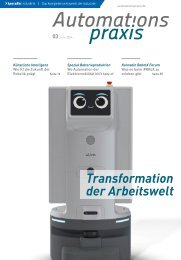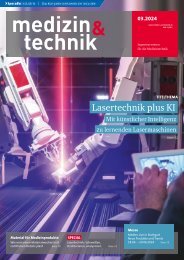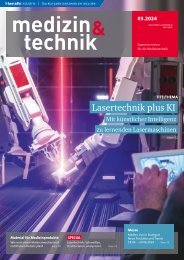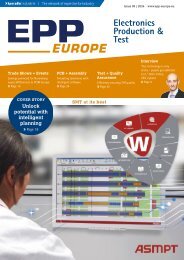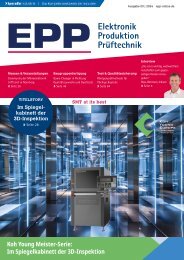cpp – Process technology for the chemical industry 01.2019
The journal cpp - Process technology for the chemical industry reports about processes, plants, apparatus and components for the chemical and pharmaceutical industry. Further topics are IT technologies, industry 4.0, digital production, MSR and automation technology and process analysis technology. The content spectrum is rounded off by explosion protection, plant safety, occupational health and safety, maintenance, site management and energy management.
The journal cpp - Process technology for the chemical industry reports about processes, plants, apparatus and components for the chemical and pharmaceutical industry. Further topics are IT technologies, industry 4.0, digital production, MSR and automation technology and process analysis technology. The content spectrum is rounded off by explosion protection, plant safety, occupational health and safety, maintenance, site management and energy management.
Create successful ePaper yourself
Turn your PDF publications into a flip-book with our unique Google optimized e-Paper software.
These pluggable modules offer segments a choice of simplex<br />
or redundant power, providing an on-board indication<br />
as well as data access via <strong>the</strong> Profinet link<br />
All Profinet redundancy structures (S2, R1 & R2) are possible<br />
using two bus couplers; <strong>the</strong> modular design results in<br />
a very small footprint depending on <strong>the</strong> application<br />
in IEC 61158, allowing customers to use<br />
<strong>the</strong> same twisted-pair wiring as when<br />
4…20 mA signals are transferred from <strong>the</strong><br />
field layer to <strong>the</strong> control level. Fieldbus<br />
topology will ultimately enable up to<br />
32 field devices to be powered using <strong>the</strong><br />
existing wiring of one 4…20 mA device<br />
and 28 V DC (instead of 24 V DC) in a<br />
15 W power trunk. Depending on <strong>the</strong> field<br />
devices <strong>–</strong> from simple temperature to<br />
complex flow or valve control <strong>–</strong> it will<br />
<strong>the</strong>n be possible to transmit far more data<br />
between <strong>the</strong> controller and <strong>the</strong> field layer.<br />
Owing to <strong>the</strong> additional digital data,<br />
plants can quickly identify anomalies and<br />
respond with predictive maintenance<br />
methods to ensure maximum system uptime,<br />
increased plant availability and improved<br />
efficiency. Ultimately, all plant assets<br />
can be used with optimum effectiveness<br />
and profitability.<br />
Profibus-PA has been deployed in plant<br />
across <strong>the</strong> globe <strong>for</strong> <strong>the</strong> past 25 years. Over<br />
eleven million Profibus-PA field devices are<br />
now installed worldwide, yet a linking device<br />
that converts Profibus-PA into Profibus-<br />
DP has always been required to connect<br />
<strong>the</strong>m to a PLC (programmable logic controller)<br />
or DCS (distributed control system).<br />
Based on a regular office and consumer environment,<br />
but without <strong>the</strong> ruggedness and<br />
high temperature capability needed on <strong>the</strong><br />
factory floor or outdoors, industrial-grade<br />
E<strong>the</strong>rnet only became possible with <strong>the</strong> invention<br />
of Profinet, which in <strong>the</strong> last two<br />
decades has become <strong>the</strong> global standard in<br />
factory automation.<br />
In 2015, standardisation ef<strong>for</strong>ts resulted in<br />
<strong>the</strong> gradual elimination of <strong>the</strong> intermediate<br />
Profibus-DP step, facilitating a direct connection<br />
between Profinet and Profibus-PA (as<br />
well as all field devices).<br />
Proxy <strong>for</strong> eight Profibus-PA segments<br />
At last year’s Achema exhibition, Phoenix<br />
Contact provided a sneak preview of a<br />
modular system that connects <strong>the</strong> existing<br />
and installed world of Profibus-PA segments<br />
directly to <strong>the</strong> Profinet protocol. Each Profibus-PA<br />
segment receives power in ei<strong>the</strong>r<br />
simplex or redundant mode and outputs<br />
14 W to a PA segment featuring a highpower<br />
trunk and being just 35 mm wide. A<br />
fully expanded proxy can be connected to a<br />
maximum of eight Profibus-PA segments<br />
and has a Profinet coupler with eight parallel<br />
connections that convert to Profinet at<br />
10/100 E<strong>the</strong>rnet speeds.<br />
The Profinet coupler <strong>–</strong> only 45 mm wide <strong>–</strong><br />
can ei<strong>the</strong>r have a simple S1 connection or<br />
be connected to two Profinet controllers via<br />
an S2 redundant mode. Fur<strong>the</strong>rmore, an R1<br />
or R2 redundant system can be configured<br />
using a second Profinet coupler.<br />
To enable easier installation and commissioning<br />
of <strong>the</strong> proxy, Phoenix Contact<br />
engineers also developed a GSDML<br />
composer that creates <strong>the</strong> GSD (general<br />
station description) in XML file <strong>for</strong>mat; this<br />
is needed by <strong>the</strong> Profinet controller to address<br />
<strong>the</strong> Profibus-PA segments connected<br />
to <strong>the</strong> proxy. The system can be modified<br />
when needed, with resulting edits of <strong>the</strong><br />
GSDML file.<br />
Profinet switches with gigabit option<br />
Over <strong>the</strong> years, Phoenix Contact has developed<br />
a comprehensive range of products <strong>for</strong><br />
<strong>the</strong> process <strong>industry</strong> including power<br />
supplies, cyber security, overvoltage protection<br />
and <strong>the</strong> well-known terminal blocks.<br />
The company also offers numerous media<br />
methods <strong>for</strong> Profibus-DP as well as o<strong>the</strong>r<br />
process automation (PA) infrastructure<br />
products such as modular and block field<br />
couplers <strong>for</strong> installation in zones 1 and 2.<br />
Only recently, Phoenix Contact launched a<br />
series of Con<strong>for</strong>mance Class B Profinet<br />
switches with both 10/100 and gigabit options<br />
in its new 2200 and 2300 series of<br />
E<strong>the</strong>rnet switches. A plethora of products<br />
with IECEx, Atex and North American Hazloc<br />
certification are available in <strong>the</strong> extensive<br />
portfolio.<br />
In summary, <strong>the</strong> digitalisation of <strong>the</strong> process<br />
<strong>industry</strong> is well under way and in <strong>the</strong> next<br />
few years many more new and exciting announcements<br />
will fur<strong>the</strong>r underline Phoenix<br />
Contact’s commitment to <strong>industry</strong> needs<br />
regarding process automation.<br />
www.<strong>cpp</strong>-net.com<br />
Online search: <strong>cpp</strong>0119phoenixcontact<br />
Hall 9, Booth F40<br />
AUTHOR:<br />
ARNOLD OFFNER<br />
Strategic Marketing Manager<br />
<strong>Process</strong> Infrastructure,<br />
Phoenix Contact<br />
<strong>cpp</strong> 01-2019 39




